Making yoghurt at home is easier than you think and is so much cheaper than buying it. Here is my guide for how to make yoghurt at home using three simple methods!
Some of the links in this post are affiliate links, which pay me a small commission for my referral at no extra cost to you! Thank you for supporting The Kiwi Country Girl.
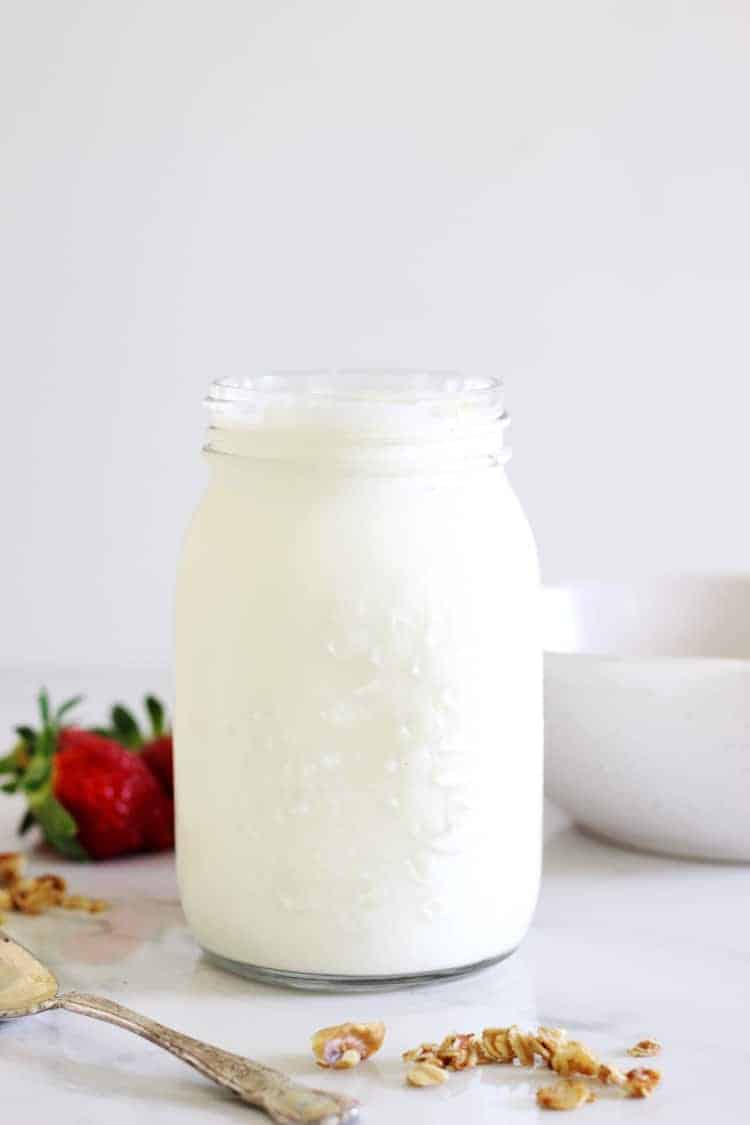
Jump to:
I've had a yoghurt maker for years and have always bought the packets of powder to make my own. It was easy, fun and definitely cheaper than buying ready made yoghurt. But then I learnt that you could make it entirely from scratch without even using the packets and I was intrigued. Just milk and yoghurt needed? Obviously I had to learn!
I looked up a few tutorials online and tried, but only had mediocre success. It was ok, but not like I thought it would be. So I asked my aunty (the one who is responsible for us having chickens, making vanilla extract and homemade granola) and she gave me her method. I was determined to make it work, and I did!
The best thing about making yoghurt at home is that once you've made it once, you can keep using the leftover yoghurt to start the next batch which means it is super cheap to make! I buy 2 litres of milk which costs around $3.50 meaning 1 litre of yoghurt costs me $1.75 to make. Not bad considering buying 1 litre of yoghurt (even plain and unsweetened) is around $5 or $6! We usually get through 1 litre of yoghurt per week, so even with my terrible maths, that means we are saving about $175 per year. I can think of plenty more things I could spend that on.
It's certainly not as simple as adding a packet to cold water, shaking and incubating but once you have the hang of it, it becomes second nature and fits into your routine easily. When I need to make more yoghurt I heat and cool the milk in the morning while we are having breakfast, then leave it incubating all day, put it in the fridge before I go to bed and it's ready to go the next morning.
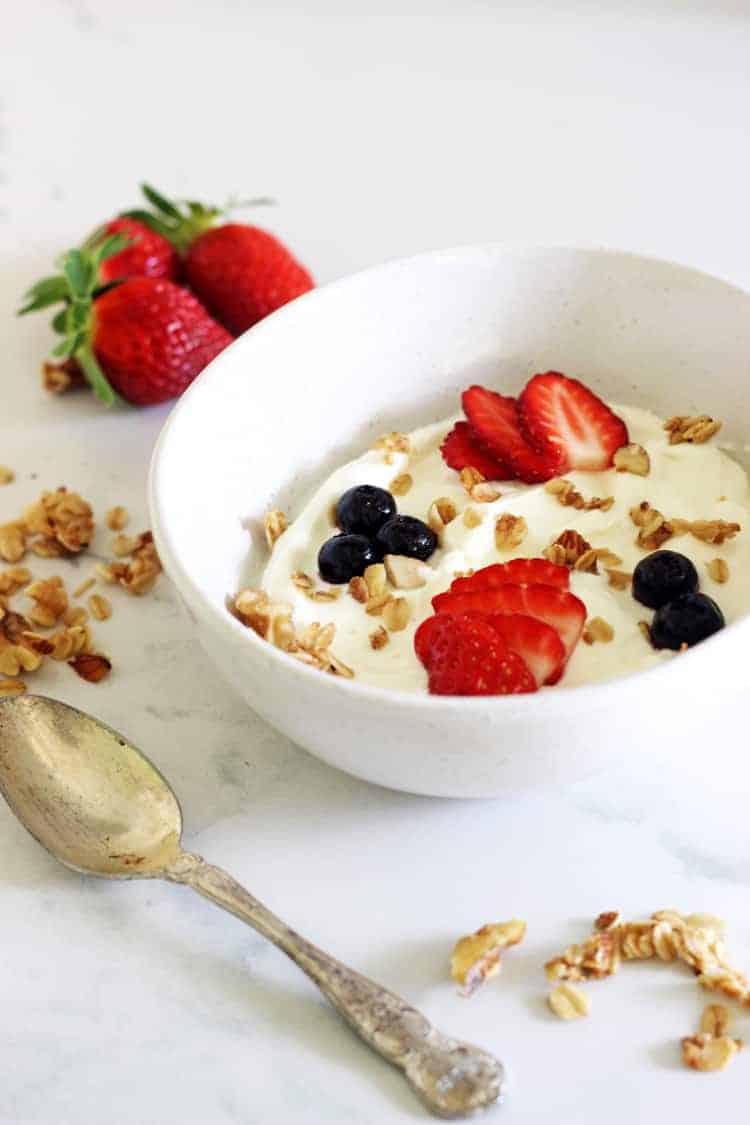
Click here to pin this post to your made from scratch recipes board on Pinterest to save it for later
Let's break it down into simple steps so that you can make yoghurt at home!
Equipment needed:
- 1 litre milk
- ¼ cup fresh yoghurt (store bought plain unsweetened yoghurt with lots of live cultures or leftover yoghurt from the last batch you made)
- Small pot
- Thermometer that can be clipped to the side of the pot (this is the one I have and love)
- 1L capacity glass jar with screw top lid (I use a 1L Agee preserving jar)
- Yoghurt maker OR oven OR slow cooker
How to make yoghurt
Step 1: Heat the milk
Pour the milk into a saucepan, clip the thermometer onto the side, turn the heat to medium and leave it for 20 minutes until it reaches 85°C/185°F. I like to set a timer so that I don't forget about it.
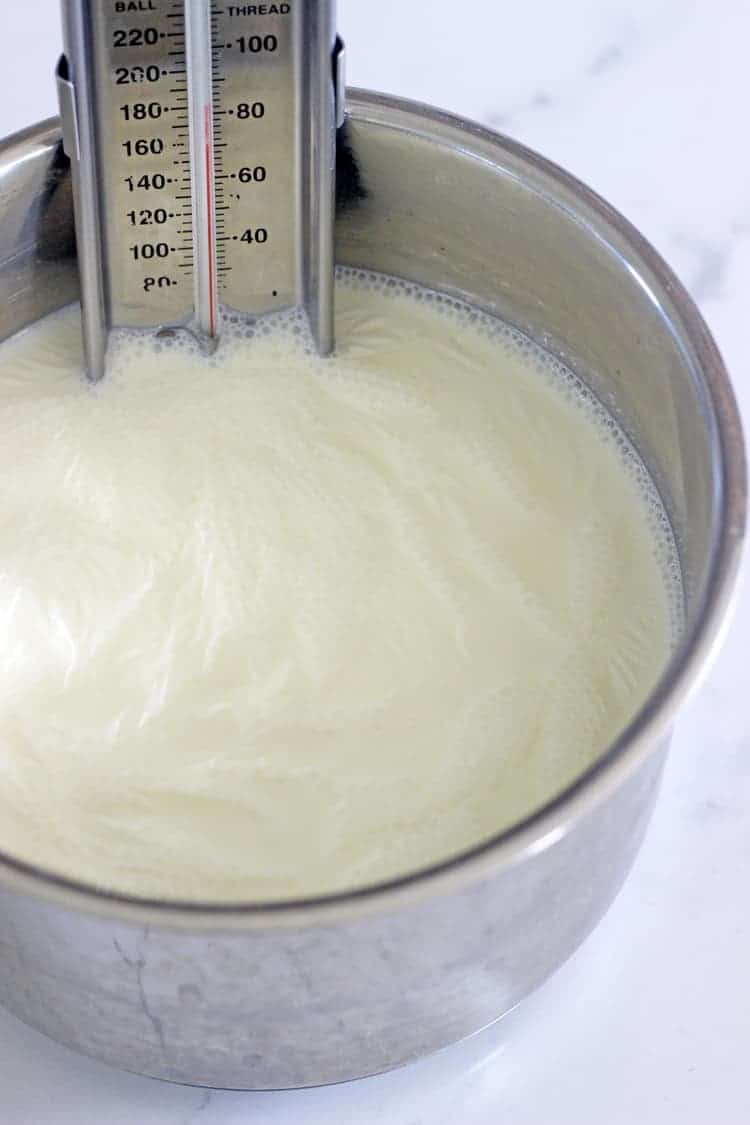
Step 2: Cool the milk
Take the pot off the element and leave it sitting for 45 minutes until it reaches 45°C/113°F. I also use my kitchen timer here.
Step 3: Mix in the yoghurt
Once the milk has cooled to the right temperature, add the yoghurt to the jar you will be using and pour in 1 cup of the milk. Stir it up and then add the remaining milk and stir again.
Step 4: Incubate
Now the yoghurt needs to be incubated so that it can turn into yoghurt! It usually takes around 4-5 hours to set but the longer you leave it, the thicker and tangier the yoghurt. I like leaving mine for around 8 hours, but you can play around with it! At this stage you have a few options depending on which method you want to use to incubate the yoghurt.
Method 1: Yoghurt maker - if you have a yoghurt maker, this is the easiest option. Pour boiling water into the bottom of the yoghurt maker (I pour in enough so that the water isn't touching the jar.) Leave on the bench for 6-10 hours.
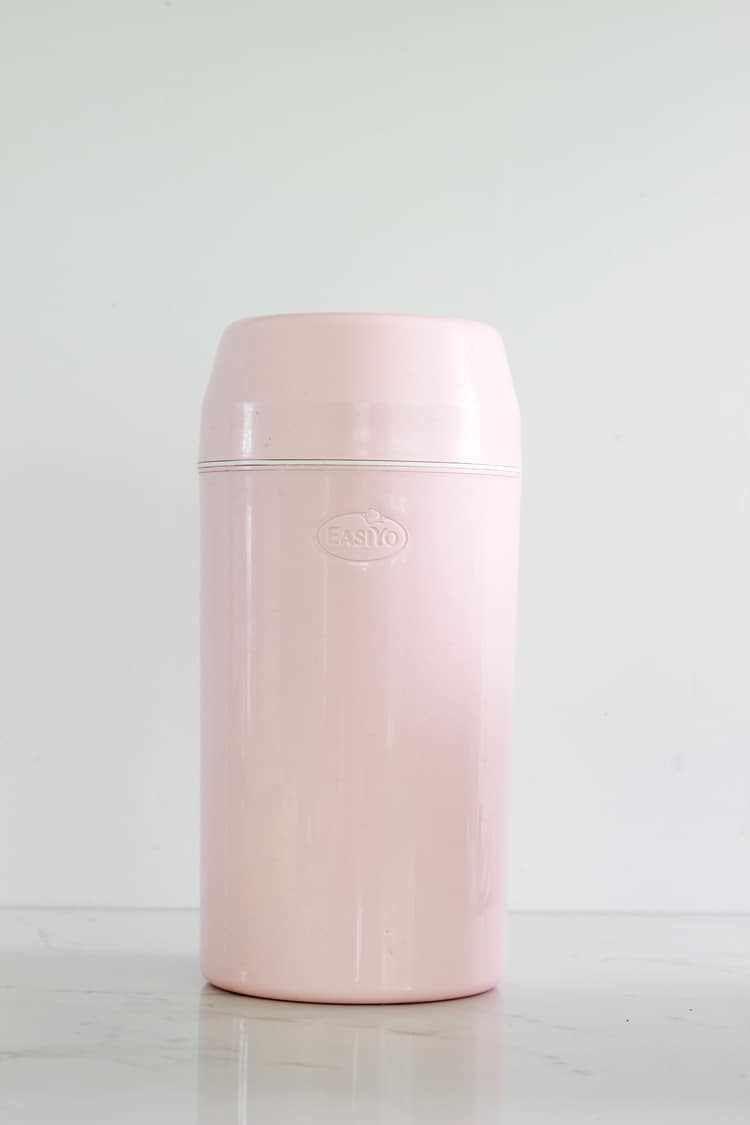
Method 2: The oven - heat the oven to the lowest temperature (it's 50°C/122°F on my oven) then turn off the oven but leave the oven light on and place the yoghurt jar in the oven. Leave for 6-10 hours.
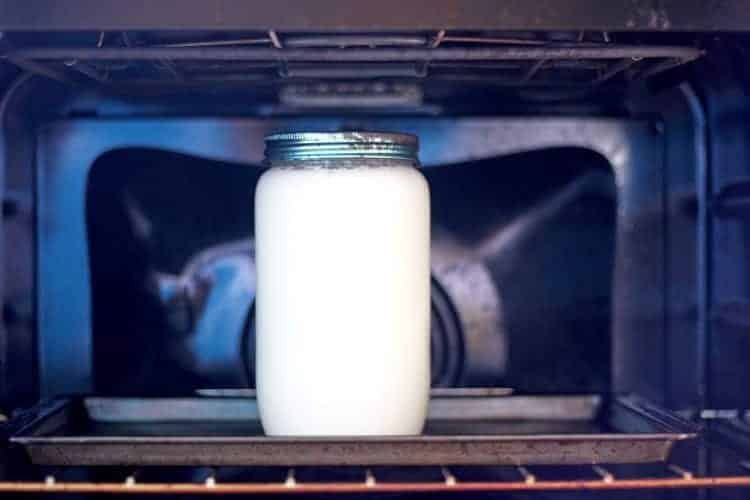
Method 3: Slow cooker - I've tried a couple of different ways with the slow cooker. The only thing to note with the slow cooker is that you may need to make your yoghurt in two smaller jars as you need to put the lid on the slow cooker. If I'm making it in the slow cooker I use 500ml Agee jars. You can half fill the slow cooker with hot tap water, place the yoghurt jar in it, wrap the whole slow cooker in a towel and leave for 6-10 hours. The other way I did it was pouring hot tap water into the slow cooker, turning it to warm and leaving the yoghurt in there for 6 hours. I didn't like this method as much as wrapping it in a towel and leaving it for longer as I felt the temperature may have got too hot.
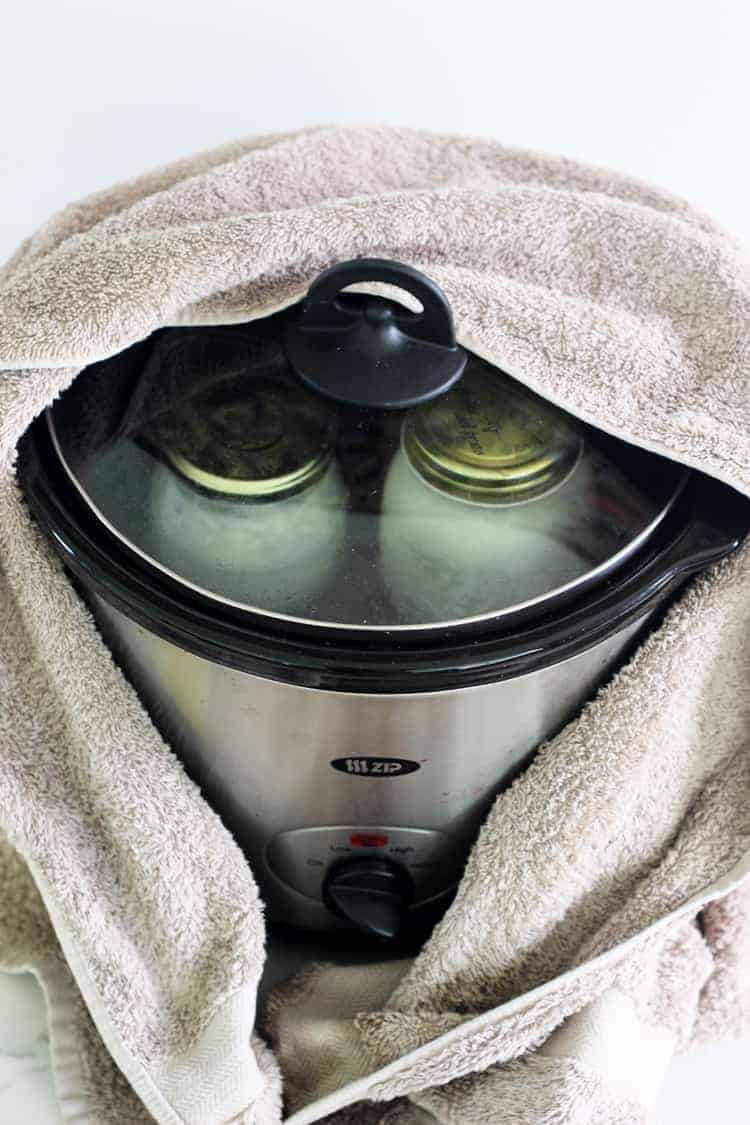
Step 5: Refrigerate
Once the yoghurt has set, it needs to be refrigerated. Place in the fridge overnight or until cooled completely. At this stage you can also stir in any flavours you like or strain it to make thicker Greek yoghurt.
To strain the yoghurt I place a sieve/strainer lined with a piece of muslin cloth over a large mixing bowl and pour the yoghurt into this. The whey will drip through into the bowl and you will be left with thick Greek yoghurt! This usually takes a couple of hours and I just leave it in the fridge. Note that when you make Greek yoghurt, you will end up with about half the quantity of yoghurt you started with, so 1 litre of normal yoghurt will give you about 500ml of Greek yoghurt.
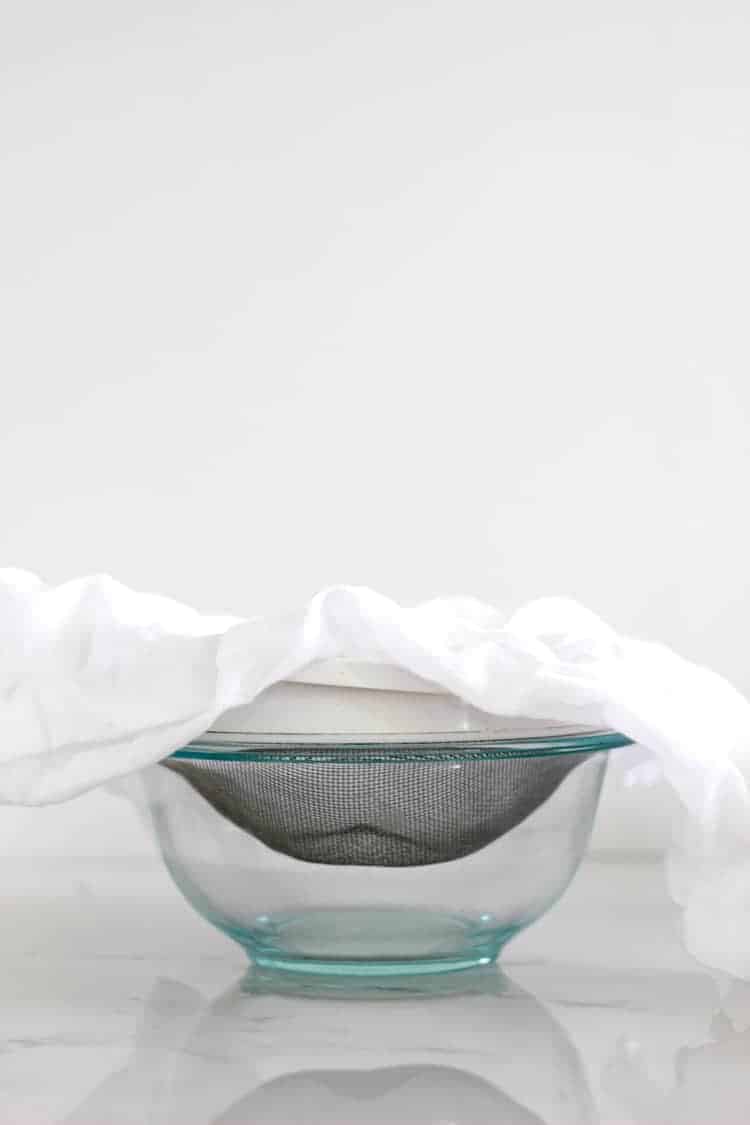
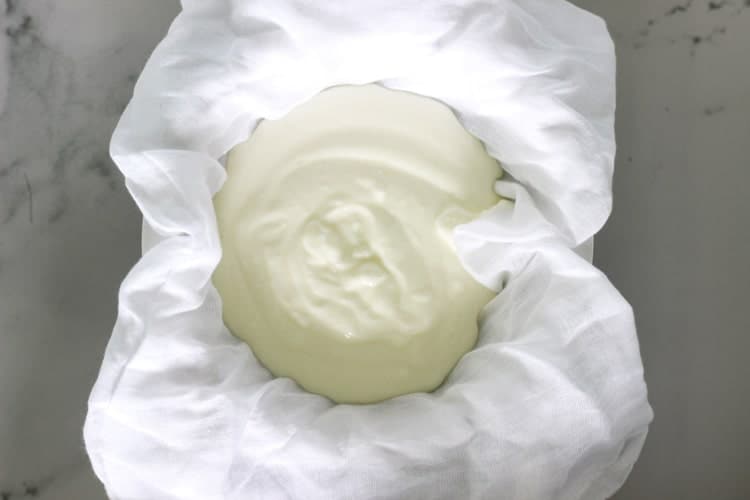
Yoghurt will store in the fridge for up to 2 weeks and you can now use the last of this homemade yoghurt to make your next batch! I made my first batch of yoghurt in March and have been using my own yoghurt to make new batches ever since!
If I had to recommend a method to start with, if you have a yoghurt maker, this is the easiest. It's the job that it's designed for and it does the job perfectly. If you don't have a yoghurt maker and don't want to rush out and buy one, the oven is a very close second. The only disadvantage of using the oven is that your oven is then tied up for 8 hours or so but other than that, it maintains heat and makes perfect yoghurt too. Leaving it overnight is a great work around if you use your oven a lot. The slow cooker is still a good way of doing it but it is less reliable as it's a lot harder to maintain the correct temperature.

FAQ's/Troubleshooting
If the yoghurt hasn't set there are a few things to check.
- Was your yoghurt fresh? Did you use plain unsweetened yoghurt with lots of live cultures?
- Was the milk the correct temperature when you added the yoghurt? Too hot and it will kill the bacteria, too cold and it won't work either
- Did the temperature of the yoghurt stay constant while you were incubating it?
If all of these things were right, you may need to start over with fresh milk and yoghurt and try again.
It will! The great thing about making yoghurt is that it is actually pretty forgiving. I have lost count of the number of times I have been trapped under a baby or outside and not heard the timer go off and come back to milk that is boiling over. The good news is, let it cool to the right temperature and it will still be fine. Likewise, if you let it get too cold, I just turn the heat back on and let it get back to the cool temperature (45°C/113°F) and continue. When this happens I find that sometimes the end result can be a little grainer than usual, but just give it a good stir and it comes right. Also, the next batch of yoghurt won't be affected by this.
I use full fat (dark blue) milk. I have also made it using light blue milk successfully.
YES! As we live so far out of town, I buy milk in bulk (think 12L at a time!) and put it in the freezer. I thaw the milk on the bench overnight and it works perfectly to make yoghurt.
I have a whole lesson on making dairy free yoghurt in my membership, The Kiwi Country Homestead
Otherwise, Cassie at Wholefully has a great tutorial on making coconut yoghurt on her website that you should check out.
We usually eat ours within a week but I've definitely kept it for 2 weeks with no problems. You will be able to tell if it's no good - it will start to separate and will smell weird. If this is the case, throw it out, don't use it to make a new batch - start over.
Yes definitely! I haven't used these methods but here are some great posts that can help you.
Instant Pot/Multi Cooker
Heating Pad
No. You can buy yoghurt culture that you can use instead of fresh yoghurt. I've never tried it but imagine it would be a great place to start or a good option to have as backup in case you run out of yoghurt!
Now you are all set to make your own yoghurt at home! If you think of any other questions that I haven't answered, comment below or send me an email!
Made this? Tag me on Instagram @thekiwicountrygirl and hashtag it #thekiwicountrygirl.
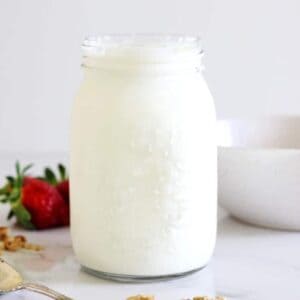
How to Make Yoghurt
Ingredients
- 1 litre milk (I use dark blue - full fat)
- ¼ cup plain, unsweetened yoghurt (with lots of live cultures)
Instructions
- Step 1: Heat the milk. Pour the milk into a saucepan, clip the thermometer onto the side, turn the heat to medium and leave it for 20 minutes until it reaches 85°C/185°F. I like to set a timer so that I don't forget about it.
- Step 2: Cool the milk. Take the pot off the element and leave it sitting for 40 minutes until it reaches 45°C/113°F. I also use my kitchen timer here.
- Step 3: Mix in the yoghurt. Once the milk has cooled to the right temperature, add the yoghurt to the jar you will be using and pour in 1 cup of the milk. Stir it up and then add the remaining milk and stir again.
- Step 4: Incubate. Now the yoghurt needs to be incubated so that it can turn into yoghurt! It usually takes around 4-5 hours to set but the longer you leave it, the thicker and tangier the yoghurt. I like leaving mine for around 8 hours, but you can play around with it! At this stage you have a few options depending on which method you want to use to incubate the yoghurt.
Method 1: Yoghurt maker - if you have a yoghurt maker, this is the easiest option. Pour boiling water into the bottom of the yoghurt maker (I pour in enough so that the water isn't touching the jar.) Leave on the bench for 6-10 hours.
Method 2: The oven - heat the oven to the lowest temperature (it's 50°C/122°F on my oven) then turn off the oven but leave the oven light on and place the yoghurt jar in the oven. Leave for 6-10 hours.
Method 3: Slow cooker - I've tried a couple of different ways with the slow cooker. The only thing to note with the slow cooker is that you may need to make your yoghurt in two smaller jars. If I'm making it in the slow cooker I use 500ml Agee jars. You can half fill the slow cooker with warm water, place the yoghurt jar in it, wrap the whole slow cooker in a towel and leave for 6-10 hours. The other way I did it was pouring hot tap water into the slow cooker, turning it to warm and leaving the yoghurt in there for 6 hours. I didn't like this method as much as wrapping it in a towel and leaving it for longer.
- Step 5: Refrigerate. Once the yoghurt has set, it needs to be refrigerated. Place in the fridge overnight or until cooled completely. At this stage you can also stir in any flavours you like or strain it to make thicker Greek yoghurt.
- Yoghurt will store in the fridge for up to 2 weeks and you can now use the last of this homemade yoghurt to make your next batch! I made my first batch of yoghurt in March and have been using my own yoghurt to make new batches ever since!



Pru Broughton says
I incubate my yoghurt in a box style dehydrator -8 hours @ 40 C
Peter van der Stam says
Hi Laura,
GREEK yoghurt????
I had made a batch of yoghurt with milk powder, which turned out ????
To much fluid !!
SO, Take a sif, hanker chief and dump the lot to separate
Yeah right. Worked very well apart from the fact that I left it too long o the bench.
Result ??HAHA, I could easily cut it with a nife into slices.
I had to put some of the whey back in.
See what the result is going to be.
Taste is still OK.
Laura says
Hi Peter, I sometimes find that the yoghurt has a layer of whey after incubating, you can either pour it off, stir it in for a thinner yoghurt or strain it as you did for a very thick Greek style yoghurt! Sounds like you had success, that's brilliant!
Peter van der Stam says
Hello Laura, What can I do with the whey after making Greek yoghurt.
I hate throwing good stuff away.
Cheers Peter
Laura says
Hi Peter,
A quick Google search for what to do with whey will give many ideas - some use it in smoothies, some use it to water plants. Personally I just tip it down the sink as it's not often much for me but do what suits you!
Peter van der Stam says
Hello Laura,
My second attempt is with milk powder and filtered water, with a bit of pure ( real ) vanilla in it.
This was not the greatest result.
So, I have taken the sif with a ( clean ??) hankerchief and am filtering the very
high lot of whey ( the fluid ) and see what comes out of that.
The taste is OK, but I think that I forget the vanilla next time. And go for a liter of milk again, with all the hoopla of heating etc.
Peter.
Peter van der Stam says
Great, my very first attempt seems to be a success.
Thanks for the recepie.
Peter van der Stam says
I am wondering what the reason for the heating till 85 Degrees is.
Would it not be possible to heat till about 45 Degrees, stir the yoghurt
starter in and incubate for 6 to 8 hours.
Other question: I do have so called Probiotics. Would that help during the incubation?
Make milk with full powder milk, would that work??
This is my first attempt.
Regards Peter van der Stam
Experimenter
Laura says
Hi Peter! There are a couple of reasons for heating the milk up to 85C first - to kill off any unwanted bacteria that may be in the milk (even though it's unlikely if you are using pasteurised milk, it's still a good step to take) and secondly, heating the milk to that temperature denatures the whey protein in the milk which results in a thicker, creamier yoghurt. I've read that if you hold it at that temperature for longer (up to 30 minutes) it can become even thicker and creamier but I've yet to try it! So it's not strictly necessary if using pasteurised milk, it will give you better results. But experiment with it and see how you go!
You can certainly add extra probiotics but they are not necessary for the yoghurt making process as the yoghurt starter should contain enough culture to make the yoghurt.
And using milk powder can certainly work - in this case I would use water that is at 45C and mix in the milk powder, then add your culture and incubate - heating this to 85C is not necessary - I have actually just made a batch using this method to test it out myself, so I will report back!
Jay says
Hi Laura,
How did it go with the powdered milk?
Laura says
Great! I just used warm water out of the tap (45°C) mixed through the milk powder and yoghurt starter and incubated and it turned out really well!
Vicky says
Hi there! Can you leave it in the oven overnight after following all other steps? So it would be in there for 17 hours if I use it as planned at a school, not in the fridge till the next morning. Would this be too long and dangerous for the bacteria growth, or still okay?
Laura says
Hi Vicky, that's absolutely fine, I've often forgotten about mine and left it incubating for 24 hours and it's fine! Might just be a bit tangier than usual but totally safe!
Leanne Dempsey says
Hi
Thankyou for sharing your recipe made it last night and it turned out perfect creamy and thick . 😋 I was so excited when I opened it up and seen how good it had worked.